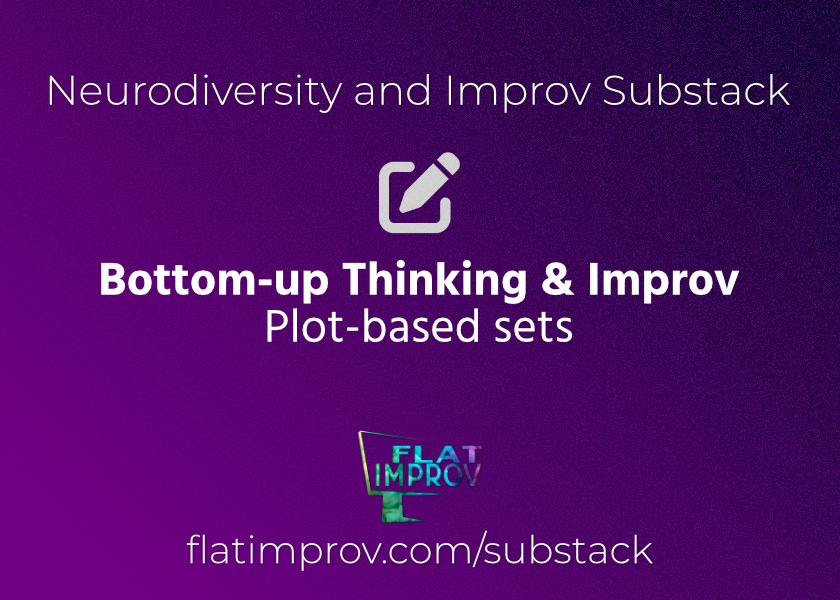Bottom Up Thinking & Improv: Plot-based sets
Improvising plot-driven sets might not come quite as naturally to bottom-up thinkers. How do you figure out the type of thinker you are, and how does it affect different parts of your improv practice?
There are many different types of thinkers and neurotypes. Every thinker can think in different ways, but will be wired in a specific way that can be detected in brain scans.
There will be overlaps in the ways people think, and there are variables that affect your process. For example, even the term "neurodivergent" is loaded and sometimes controversial. It started off as a way to make autism become more accepted and understood by society, but the term has of course evolved and caused a lot of discussion and debate and disagreement.
But neurodivergent and neurotype are often used to refer to the different ways a person processes information, different thinking styles. And they’re related to todays topic: top-down and bottom-up thinking.
The way we think affects the way we learn, do, and perform improv. And different ways of thinking can complement your scene partner(s) and balance out a team and/or show.
It helps to have a detailed (or at least thoughtful) understanding of what each person brings to a team in terms of their strengths. And this strength can include the way we think or process information.
And it also helps to understand this for YOURSELF. You can focus on getting really, extra, bonus-level good at what YOU do good. Do all the things, learn all the things, and play to your natural strengths most often.
The podcast episode for this article
This article was originally a podcast episode, in this case episode 3. This article has a number of differences from the podcast episode, so even if you listened to it you might gain some additional insight from this article.
I also tend to remove some content that I spoke about (or never made notes for it, maybe…). So there will likely be some additional content in the pod ep, and additional stuff here.
I tend to add and revise, and especially now since quite some time has passed since I recorded this one. Anyway.
You can find the podcast ep here if you want it:
Using details to build concepts
This article will cover one of those types - bottom up thinking. I’ll explore how this form of cognitive processing affects a specific thing in improv: narrative plot lines (including unintentional forays into plot-driven sets).
Note: Bottom-up thinking affects a lot in improv, much more than just plots. I will cover bottom-up thinking in several different contexts in other articles and episodes.
Autism, as its own neurotype, has several different ways of thinking or processing. Bottom-up thinking (or bottom-up processing) is common amongst autistic people.
And the relationship with plots or plot lines might also be affected by ADHD and auditory processing mixed in. Probably other things too. It’s often hard to know where one thing begins and another ends. But the main point here is to figure out how it all works for you in your own brain.
What is bottom up thinking or processing
So what is bottom-up thinking and top-down thinking?
Top-down thinking takes prior experiences into account to sort of form a concept, hypothesis, a general idea — then clarify data through learning details. Top-down will take one piece of new info and map it to a generalized idea they already know. You deduce things.
Bottom-up thinking operates in the other direction. You take in the details, all the small details from any source, in a rather thorough manner. Then you put those details together in order to form some kind of theory, concept, or understanding.
Bottom-up thinkers are not used to making generalizations or hypotheses until after the details are sussed out. In fact, making assumptions (or... hypotheses) prior to information gathering can aggravate me! Despite it being a very standard way of doing science - nothing wrong with it.
However, I will say things like “why are we even talking about this when we’re just making assumptions or guesses. Let’s get all the details first.” Or I'll have to think about something before discussing further.
I've said these sorts of phrases a lot to people. I'm that person (well, at least when I'm not masking I guess). And if I don’t say this, and I’m put on the spot to try and top-down process a high-stakes issue, I might sweat and act bonus-level weird.
But: it's the default wiring I acquired, maybe it’s yours too.
An inductive approach to information
So bottom up processing of information is an inductive approach. You get all the details before forming a concept, an overview, an opinion, or make a decision. It's the way I put these articles/episodes together (or anything else): I barf everything out while researching or brainstorming more, then categorize, then summarize, then refine (though will often continue to add more detail... still).
I guess I should add all the while I will think and monologue in my head about all of the data on loop while refining my eventual summary/hypothesis/opinion. Fun? Exhausting? It’s fun! It’s exhausting! Especially if I’m really into the topic.
Keep reading with a 7-day free trial
Subscribe to Neurodivergent Minds in Comedy / Neurodiversity in Improv to keep reading this post and get 7 days of free access to the full post archives.






